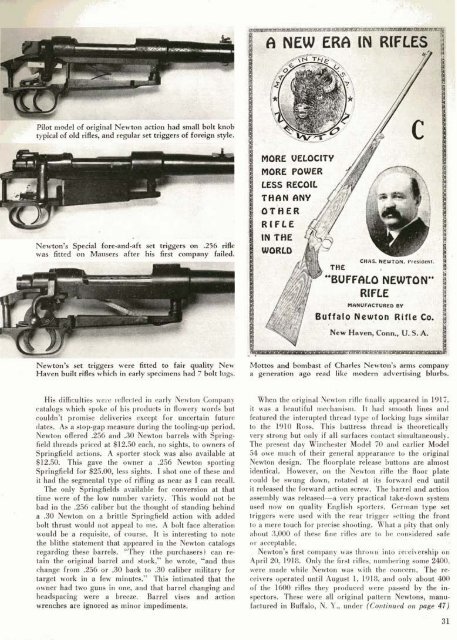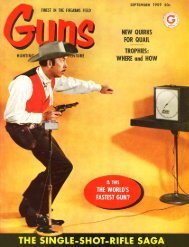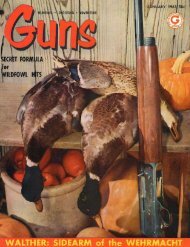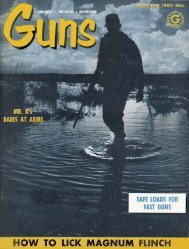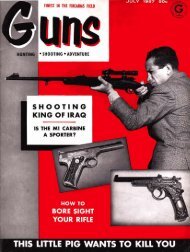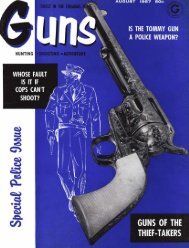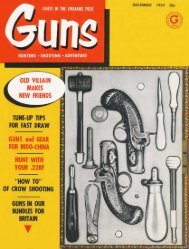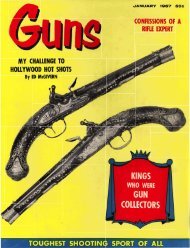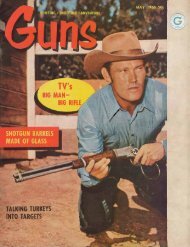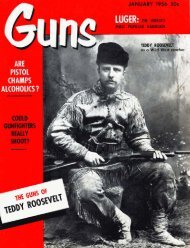You also want an ePaper? Increase the reach of your titles
YUMPU automatically turns print PDFs into web optimized ePapers that Google loves.
Pilot model of original Newton action had small bolt knob<br />
a. tvoical of old rifles, and regular set trieeers of foreien style.<br />
Newton's Special fore-and-aft set triggers on .256 rifle<br />
was fitted on Mausers after his first company failed.<br />
Newton's set triggers were fitted to fair quality New<br />
Haven built rifles which in early specimens had 7 bolt lugs.<br />
His difficulties were reflected in early Newton Company<br />
catalogs which spoke of his products in flowery words but<br />
couldn't promise deliveries except for uncertain future<br />
dates. As a stop-gap measure during the tooling-up period.<br />
Newton offered .256 and .30 Newton barrels with Spring-<br />
field threads priced at $12.50 each, no sights, to owners of<br />
Springfield actions. A sporter stock was also available at<br />
$12.50. This gave the owner a .256 Newton sporting<br />
Springfield for $25.00, less sights. I shot one of these and<br />
it had the segmental type of rifling as near as I can recall.<br />
The only Springfields available for conversion at that<br />
time were of the low number variety. This would not be<br />
bad in the .256 caliber but the thought of standing behind<br />
a .30 Newton on a brittle Springfield action with added<br />
bolt thrust would not appeal to me. A bolt face alteration<br />
would be a requisite, of course. It is interesting to note<br />
the blithe statement that appeared in the Newton catalogs<br />
regarding these barrels. "They (the purchasers) can re-<br />
tain the original barrel and stock," he wrote, "and thus<br />
-<br />
change from .256 or .30 back to .30 caliber military for<br />
target work in a few minutes." This intimated that the<br />
owner had two guns in one, and that barrel changing and<br />
headspacing were a breeze. Barrel vises and action<br />
wrenches are ignored as minor impediments.<br />
Mottos and bombast of Charles Newton's arms company<br />
a generation ago read like modern advertising blurbs.<br />
When the original Newton rifle finally appeared in 1917,<br />
it was a beautiful mechanism. It had smooth lines and<br />
featured the interupted thread type of locking lugs similar<br />
to the 1910 Ross. This buttress thread is theoretically<br />
very strong but only if all surfaces contact simultaneously.<br />
The present day Winchester Model 70 and earlier Model<br />
54 owe much of their general appearance to the original<br />
Newton design. The floorplate release buttons are almost<br />
identical. However, on the Newton rifle the floor plate<br />
could be swung down, rotated at its forward end until<br />
it released the forward action screw. The barrel and action<br />
assembly was released-a very practical take-down system<br />
used now on quality English sporters. German type set<br />
triggers were used with the rear trigger setting the front<br />
to a mere touch for precise shooting. What a pity that only<br />
about 3.000 of these fine rifles are to be considered safe<br />
or acceptable.<br />
Newton's first company was thrown into receivership on<br />
<strong>April</strong> 20, 1918. Only the first rifles, numbering some 2400.<br />
were made while Newton was with the concern. The re-<br />
ceivers operated until August 1, 1918, and onlyabout 400<br />
of the 1600 rifles they produced were passed by the in-<br />
spectors. These were all original pattern Newtons, manu-<br />
factured in Buffalo, N. Y., under (Continued on page 47)


